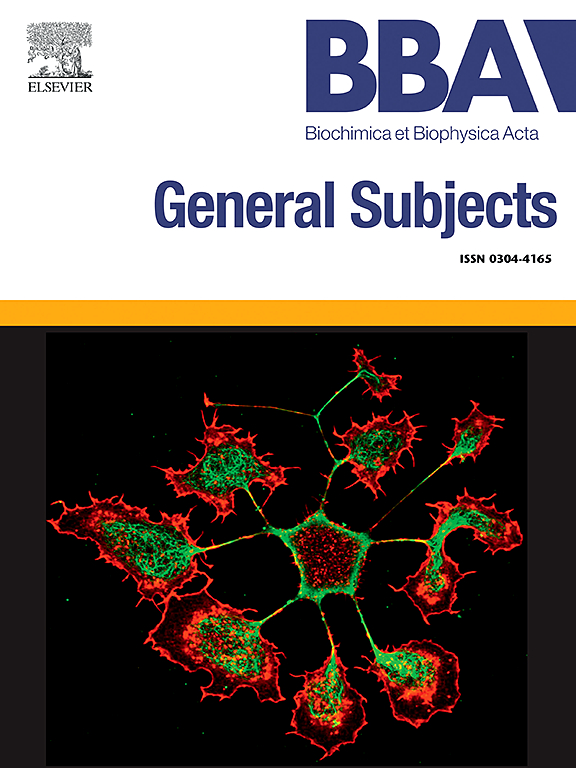Computational analysis of the alpha−2 domain of apolipoprotein B − 100, a potential triggering factor in LDL aggregation
IF 2.2
3区 生物学
Q3 BIOCHEMISTRY & MOLECULAR BIOLOGY
Biochimica et biophysica acta. General subjects
Pub Date : 2025-02-01
DOI:10.1016/j.bbagen.2024.130742
引用次数: 0
Abstract
Atherosclerosis, the major underlying cause of cardiovascular disease, is believed to arise from the accumulation of low-density lipoprotein (LDL) in the arterial subendothelial space, ultimately leading to plaque formation. It is proposed that the accumulation of LDL is linked to its intrinsic aggregation propensity. Although the native LDL is not prone to aggregation, LDL(−), an electronegative LDL characterized in the plasma, has been shown to prime LDL aggregation in a domino-like behavior similar to amyloidogenic proteins. LDL(−) has also been observed to have a misfolded apolipoprotein B-100 (apo B-100), a huge protein consisting of 4563 amino acid residues. As misfolding of proteins is commonly associated with amyloid formation, apo B-100 is therefore being considered as the possible triggering factor in LDL aggregation. Previous computational studies have implicated the α2 domain to be the aggregation-prone region of apo B-100. In this study, the amyloidogenic properties of the α2 domain of apo B-100 were interrogated using both in silico and in vitro techniques.
Since the crystal structure of the 570-amino acid α2 domain of apo B-100 is yet to be solved, we used several secondary structure prediction tools to model putative helical regions that make up the α2 domain. The stability of each of the 17 helices thus identified was further probed using molecular dynamics (MD), with the least stable of the helices considered as potentially amyloidogenic. In a 100 ns simulation window, helices k (YFEKLVGFIDDAVK), m (YHQFVDETNDKIREVTQRLNGEIQA), and p (QQELQRYLSLVGQVYS) were the least stable and appeared to transition to β-structures, the hallmark of amyloidogenesis. When the simulation was extended to longer times, only helices k and p formed stable β-sheets that persisted. Analysis of the data indicates that the final β-sheet conformation was stabilized by the π-π stacking interactions between the aromatic rings of Tyr-1 and Phe-8 for helix k and likely π-π stacking contacts between Arg-6 guanidino group and Tyr-15 ring for helix p.
Based on the in silico work, we proceeded to synthesize and spectroscopically characterize helices k, m17–25 (QRLNGEIQA), and p. As expected, k and p formed detectable amyloids, with the latter appearing to be substantially more amyloidogenic based on kinetic aggregation assays. Amyloid fibrils formed by p were confirmed using circular dichroism spectroscopy and transmission electron microscopy. Data obtained could be exploited to further investigate the roles of peptides derived from the α2 domain helices of apo B-100 in triggering LDL aggregation. Based on preliminary data, one of the peptides designed based on this work reduced the aggregation of LDL.

载脂蛋白B α -2结构域 - 100的计算分析,这是LDL聚集的潜在触发因子。
动脉粥样硬化是心血管疾病的主要潜在原因,被认为是由动脉内皮下空间低密度脂蛋白(LDL)的积累引起的,最终导致斑块的形成。有人提出LDL的积累与其内在的聚集倾向有关。虽然天然LDL不容易聚集,但LDL(-),一种在血浆中具有电负性的LDL,已被证明以类似于淀粉样蛋白的多米诺骨牌行为引发LDL聚集。LDL(-)也被观察到有一个错误折叠的载脂蛋白B-100(载脂蛋白B-100),一个由4563个氨基酸残基组成的巨大蛋白质。由于蛋白质的错误折叠通常与淀粉样蛋白的形成有关,因此载脂蛋白B-100被认为是LDL聚集的可能触发因素。先前的计算研究表明α2结构域是载脂蛋白B-100的聚集易发区域。在这项研究中,我们用硅和体外技术研究了载脂蛋白B-100 α2结构域的淀粉样变性。由于载脂蛋白B-100的570个氨基酸α2结构域的晶体结构尚未解决,我们使用了几个二级结构预测工具来模拟推定的构成α2结构域的螺旋区域。用分子动力学(MD)进一步研究了17个螺旋的稳定性,其中最不稳定的螺旋被认为是潜在的淀粉样蛋白。在100 ns的模拟窗口中,螺旋k (YFEKLVGFIDDAVK), m (YHQFVDETNDKIREVTQRLNGEIQA)和p (QQELQRYLSLVGQVYS)是最不稳定的,并且似乎转变为β-结构,这是淀粉样变性的标志。当模拟延长到更长的时间时,只有螺旋k和p形成了持续存在的稳定β片。数据分析表明,最终的β-薄片构象是由螺旋k的tyr1和phe8芳香环之间的π-π堆叠相互作用以及螺旋p的Arg-6胍基与tyr15环之间可能的π-π堆叠相互作用稳定的。在硅工作的基础上,我们继续合成和光谱表征了螺旋k, m17-25 (QRLNGEIQA)和p。根据动力学聚集试验,后者似乎更具有淀粉样变性。通过圆二色光谱和透射电镜证实了p形成的淀粉样原纤维。获得的数据可用于进一步研究载脂蛋白B-100 α2结构域螺旋衍生的肽在触发LDL聚集中的作用。根据初步数据,基于这项工作设计的肽之一减少了LDL的聚集。
本文章由计算机程序翻译,如有差异,请以英文原文为准。
求助全文
约1分钟内获得全文
求助全文
来源期刊

Biochimica et biophysica acta. General subjects
生物-生化与分子生物学
CiteScore
6.40
自引率
0.00%
发文量
139
审稿时长
30 days
期刊介绍:
BBA General Subjects accepts for submission either original, hypothesis-driven studies or reviews covering subjects in biochemistry and biophysics that are considered to have general interest for a wide audience. Manuscripts with interdisciplinary approaches are especially encouraged.
 求助内容:
求助内容: 应助结果提醒方式:
应助结果提醒方式:


